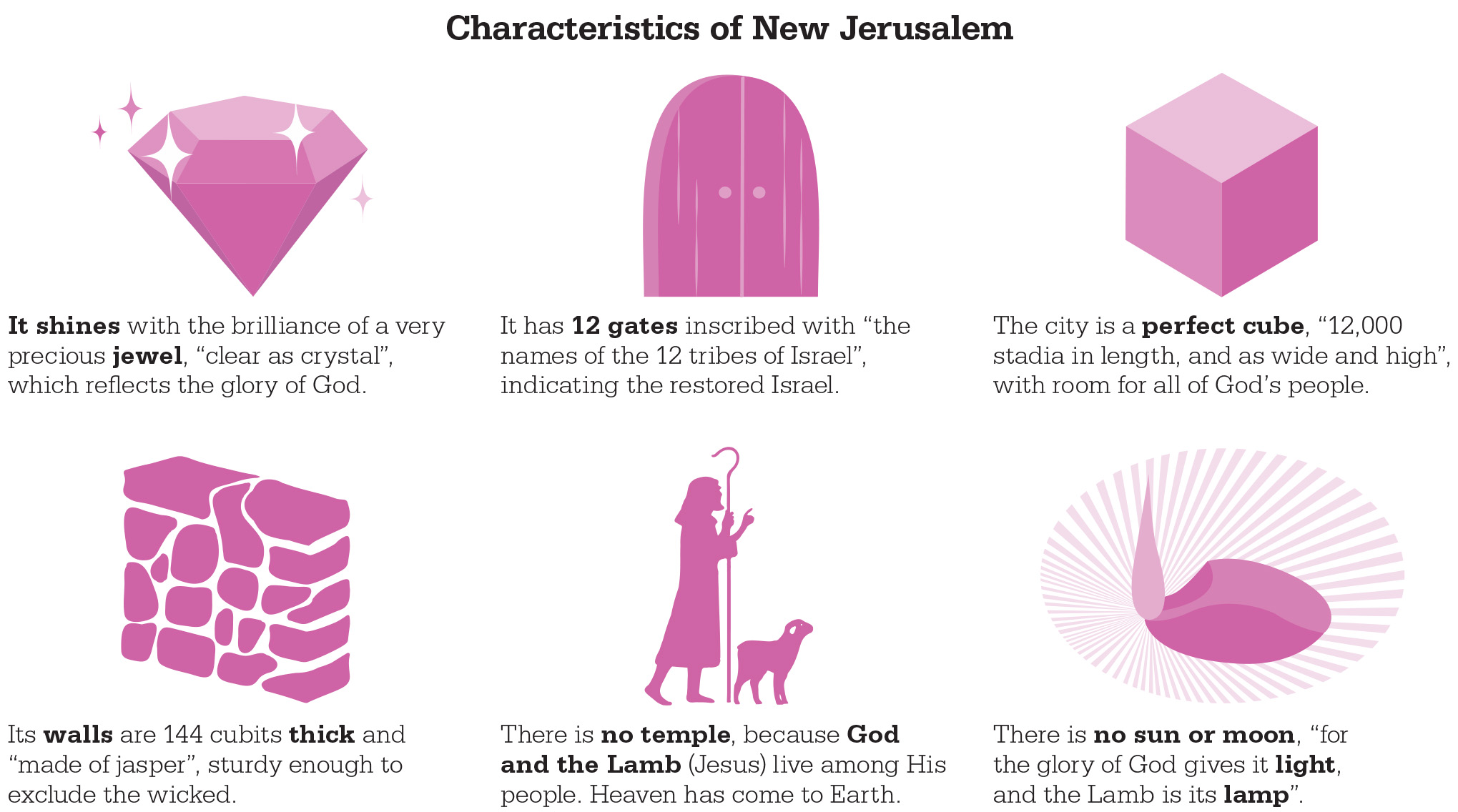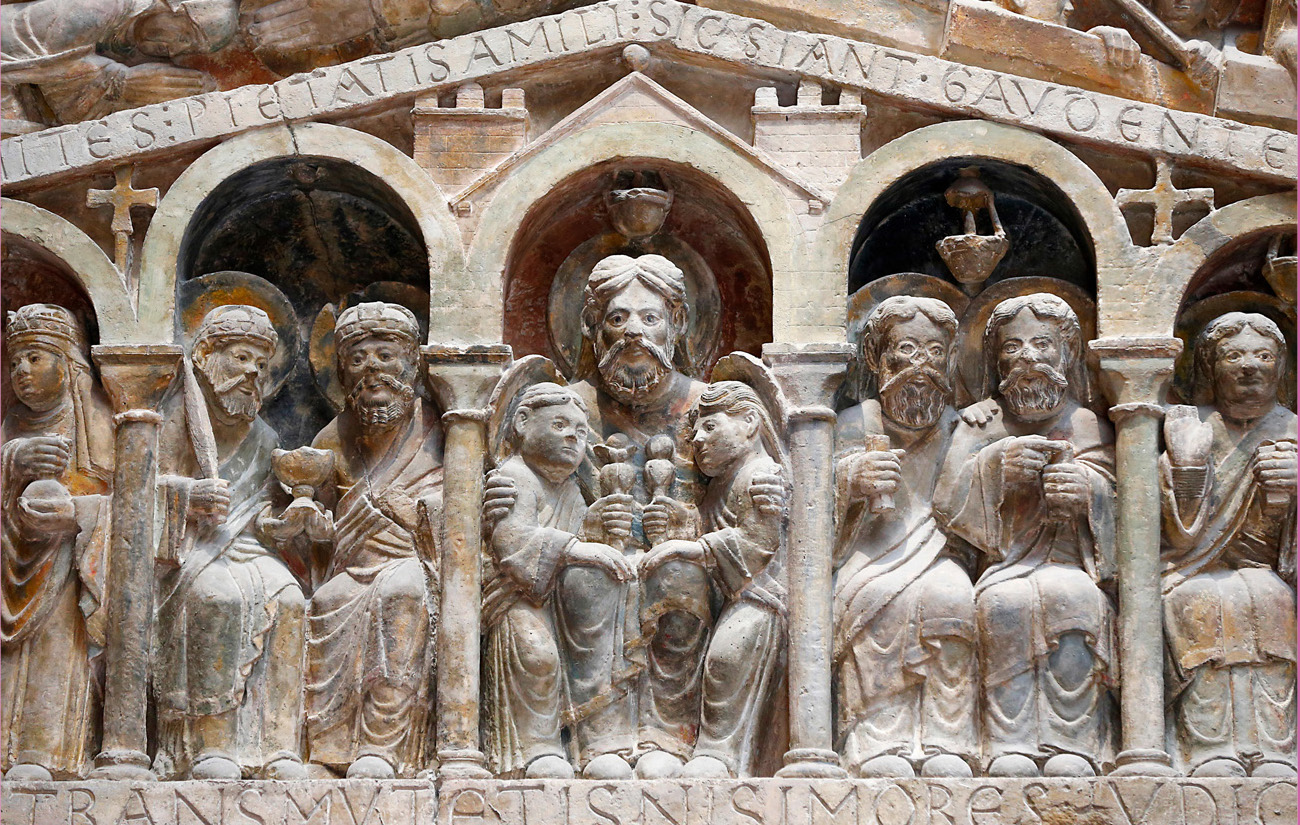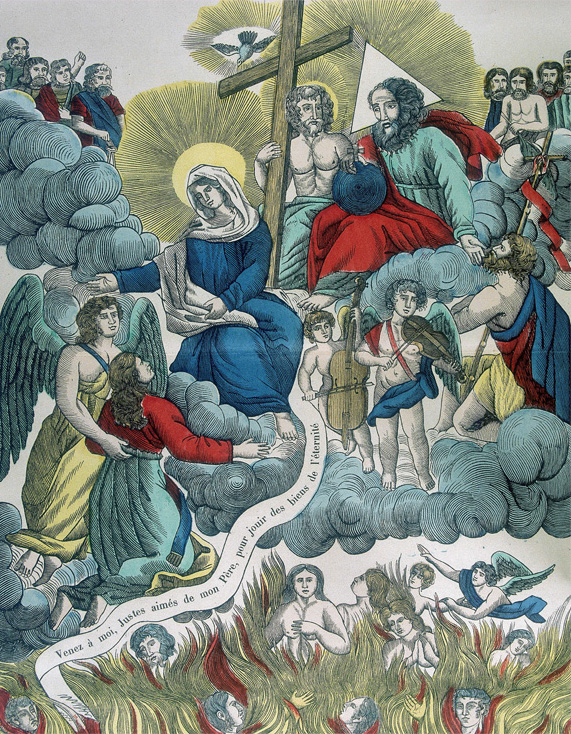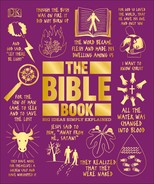
IN BRIEF
Revelation 21–22
Eschatology (the end of all things)
Future time Heaven and Earth.
Jesus At the center of the vision, God’s chosen King rules with peace from the New Jerusalem.
The saints God’s people who are welcomed to the marriage feast of heaven and Earth.
John of Patmos The narrator of Revelation (sometimes identified as Jesus’s disciple John), who received the vision described while in exile on the island of Patmos.
In the final pages of the Bible, the story of God and the world, which began with the first words of Genesis, concludes with an extraordinary vision of a glorious city where God reigns supreme. Despite recording many human failings and frequent rebellions against God, in its last chapters the Bible returns to the universal subject matter with which it began: the creation of perfection. Heaven and Earth are renewed and the stage is set for God to manifest His loving relationship with the people He has made and saved.
John receives his vision of “a new heaven and a new Earth” after the judgment of the dead and the banishment to the lake of fire of those whose evil deeds and unbelief made them unworthy of inclusion in the Book of Life (Revelation 20:12–15). We are told that “the first Heaven and the first Earth had passed away” (21:1). The heavens and elements having been destroyed by fire, the way is cleared for God’s new creative work.
John adds a specific detail to this passing: “and there was no longer any sea.” For the Israelites, the sea was always a symbol of chaos and danger. During the Exodus, for example, the sea stood between them and safety from Pharaoh, and in the New Testament, Jesus calms “a furious storm” that terrifies His disciples as they sail on the Sea of Galilee (Matthew 8:23–27). In John’s vision, all that threatens the life of God’s people has been banished from the new creation.
Apocalyptic language
The Book of Revelation is one of a number of biblical passages that can be categorized as “apocalyptic.” The term comes from the Greek apokaluptó (“to uncover”). Apocalyptic literature foretells cataclysmic events that will occur when the world ends; sometimes, as in the book of Daniel, apocalyptic symbols such as supernatural beasts represent contemporary persecutors. Such literature also typically presents a fantastical picture of God’s throne room and those who serve in heaven. Trying to evoke what cannot be put into words, apocalyptic language uses vivid imagery and driving narrative to tell the story of God’s ultimate triumph. Although such language may be difficult to understand, clues link certain passages to their historical context. For instance, “Babylon” here is understood to refer to the Roman Empire. Christians through the ages have reinterpreted this language to proclaim the victory of God’s Kingdom and the expectation of God’s City of Peace.


The new City of Peace
John then sees “the Holy City, the New Jerusalem, coming down out of heaven from God” (Revelation 21:2). Jerusalem, which means “City of Peace,” had been a focus of life for the Israelites since it became King David’s capital city. Despite its name, it had also been a place of conflict from David’s time onward. Human efforts to bring about lasting peace had always dissolved into strife. Following the violent warfare of the previous chapters of Revelation, John now sees a City of Peace, prepared by God Himself, being established on Earth. This signals the fulfillment of repeated promises throughout the Bible that one day God will end all world conflicts by asserting His peaceful rule. God’s chosen King, now known to be His Son Jesus, is the “Prince of Peace” and “Of the greatness of His government and peace there will be no end. He will reign on David’s throne and over His kingdom … from that time on and forever” (Isaiah 9:6–7).
God with His people
The arrival of God’s home on Earth also satisfies the pledge that He had made to His people long ago, when He said, “I will take you as my own people, and I will be your God” (Exodus 6:7). There have been moments throughout the Bible when this promise has seemed in doubt, when God’s people have strayed from His path, and when God has seemed distant and even hidden while His people suffer. But now, God is at home among His people, sharing the same space, and all the suffering of the past is wiped away. “There will be no more death or mourning or crying or pain, for the old order of things has passed away” (Revelation 21:4). John hears a loud voice from God’s throne announcing, “I am making everything new!” (21:5).
“See, I will create new Heavens and a new Earth.”
Isaiah 65:17

The shining city
John now gets a further glimpse of the New Jerusalem, as one of God’s angels takes him around the city, which shines with the glory of God. Jerusalem’s outer wall is made of jasper, a precious stone that is usually opaque, but here it is transparent; light passes through the wall, revealing what is within the city. Everything is exquisite: the enormous city gates are each made of a single pearl, and the city’s great street is pure gold.
In the Bible, the number 12, often symbolizing perfection, signifies the completeness of the nation of Israel. The walls around the New Jerusalem have 12 gates—three on each of its four sides—and an angel standing by every gate. The gates bear the names of the 12 tribes of Israel, reassuring John that none of God’s faithful people will be excluded. The wall has 12 foundations, inscribed with the names of the 12 apostles, and decorated with 12 kinds of precious stone. When the angel measures the city, its length, breadth, and height are each 12,000 stadia (1,400 miles/2,200km) and the walls are 144 cubits (about 200ft/65 meters) thick.
Most striking of all, John notices that the Temple is missing from the New Jerusalem. The Temple had been the greatest building in the Old Jerusalem, being the focus of Jewish worship and the meeting point between heaven and Earth. Now, no such meeting point is needed, because God Himself lives in the city—heaven has come to Earth. The light of God’s presence shines from the city into the whole world, and all the people from every nation whose names are in the Book of Life stream through the gates, guided by God’s light, to bring their worship and devotion into God’s presence.
“For the Lord Himself will come down from Heaven, with a loud command … and with the trumpet call of God, and the dead in Christ will rise first.”
1 Thessalonians 4:16
A vision to be shared
The angel brings John into the city, where he sees a mighty river flowing from God’s throne down the golden street. The Tree of Life, last seen in the Garden of Eden, is growing on the banks of the river. It is so large that it straddles both sides of the river, and so fruitful that it bears a significant 12 crops every year. Its leaves bring healing to the nations and finally do away with the pain and suffering that have marred humanity’s existence since Creation (22:1–3). God’s people joyfully serve Him here, and their new life goes on forever.
After receiving the dazzling vision of God’s promised future, John is so overwhelmed that he falls down at the feet of the angel who has been guiding him. But the angel lifts him up and reminds him that he is just a messenger. John should not be overawed by the image of the New Jerusalem, but rather by the goodness and glory of God the Father, His Son, and the Holy Spirit, who alone can bring it to pass. John is told to share his vision to motivate God’s people to do good. In the words of God, the angel says, “Let the one who does wrong continue to do wrong; let the vile person continue to be vile; let the one who does right continue to do right; and let the holy person continue to be holy” but warns, “I will give to each person according to what they have done” (22:11–12).
In the final verses of Revelation, John returns to an image that emphasizes the relationship of love that God longs to have with all people. When John first saw the New Jerusalem, he described it as “a bride beautifully dressed for her husband” (21:2). Now, at the end of the vision, this “bride”—God’s people, collectively cleansed from sin and dressed in the robes of righteousness—awaits the groom, Jesus, God’s Son, the true king of all. The marriage and celebrations will signal the beginning of the new life of eternity, where heaven and Earth are wedded together, God’s home is among His creation, and all of God’s people, that is “everyone who does right,” will be released from sin and death to live in holy freedom forever. The vision ends with a longing cry for this future, “Come, Lord Jesus” (22:20).
“Let us rejoice and be glad and give Him glory! For the wedding of the Lamb has come, and His bride has made herself ready.”
Revelation 19:7
The Kingdom of Heaven

The terms “kingdom of Heaven” and “kingdom of God”’ are used extensively by Jesus in His teaching to refer to God’s righteous reign on Earth. The arrival of Heaven’s kingdom on Earth is the purpose of Jesus’s ministry. He says, for instance, “Repent, for the kingdom of Heaven is near” (Matthew 4:17), and uses it as the motivation for prayer, “Your kingdom come, Your will be done, on Earth as it is in heaven” (Matthew 6:10). In popular imagination, heaven is often thought of as a spiritual, non-physical realm. The early Christians, however, building on the convictions of Jewish faith, understood heaven as the reality of living under God’s order, as directed by Him.
While some might perceive heaven as existing elsewhere, the Christian hope is for heaven to come to Earth, so that God’s rule is established in the physical world. Such a hope reassures Christians that the injustices of this life will be made right in God’s future, and that death is not the end, but rather—for those with faith—a gateway into God’s kingdom.
Interpreting the vision
John’s vision in Revelation is the basis for Christian eschatology, a word that means “the study of last things” and is an attempt to describe the indescribable. His words depict the end of evil and the beginning of God’s reign of peace in awe-inspiring detail. Over the centuries, some people have tried to fit the visions of Revelation into a chronology, using them to predict when the world will end. Given Jesus’s warning that “You do not know when that time will come” (Mark 13:33), it seems better to focus on what God’s future looks like rather than when it will occur.
One key theme of eschatology is recapitulation, which means that the end is a summary of all that has gone before, and a return to its original purpose. The Bible begins in Genesis with a picture of God in harmony with His good creation, and ends in Revelation with evil destroyed forever and that harmony restored. The reality of the long, hard history of sin and suffering that lies between is not simply denied, however. In Genesis, creation is good simply by virtue of its origin in God, but in Revelation, the future is good, both because of its origin in God and because it has been set free from sin by the death and resurrection of Jesus. From the earliest days of Christianity, believers looked forward to when God would gather up those with faith in Him from the four corners of the world to celebrate God’s glory. This picture, which appears in many of Jesus’s parables, is stated by Paul the Apostle. God’s purpose—“to be put into effect when the times reach their fulfillment”—is “to bring unity to all things in Heaven and on Earth under Christ” (Ephesians 1:10).


The promise of new life
Central to this “recapitulation” is the expectation that all God’s people who have ever lived will be physically present. Throughout the Bible, there is a growing understanding that death is not the end for those who have a place in God’s family. Since justice is often not received in the present life, Old Testament prophets look forward to a future time when the wrongdoers will be punished and God’s faithful dead will be raised (Isaiah 26:19). Jesus affirms this expectation and extends it when He himself is raised from the grave to a new life. Christian logic sees a correlation between Jesus’s resurrection and ours. Jesus is resurrected because He has defeated sin and death, and the grave could not hold Him. Jesus has ascended to heaven and is waiting for the moment when the present creation has “passed away” and God’s new creation is revealed.
Jesus is described by Paul the Apostle as the “first fruits of those who have fallen asleep,” (1 Corinthians 15:20). The words “first fruits” and “fallen asleep” are believed to indicate that what happened to Jesus will happen to those who die in faith, “that God will bring with Jesus those who have fallen asleep in Him” (1 Thessalonians 4:14). At the new creation, Christians believe that they, too, will share a new life as all things return to their original purpose of worshipping and service to God in a relationship of love.
Heaven on Earth
For centuries, an image of the afterlife as a vague, heavenly realm where people float around playing angelic harps has captured popular imagination. The eschatology of the Bible has little to do with this idea. Christians look forward to the coming of heaven on Earth. This means that every part of the world we know will be transformed by the rule of Jesus, the King of the City of Peace, the New Jerusalem. Evil will have been destroyed, the old will disappear to be replaced by the new, providing a fresh start for all who believe. At death, Christians who have “fallen asleep,” secure in God’s presence, await resurrection in the new creation. Christian eschatology reaches a grand finale: at some unspecified moment, a sumptuous wedding feast will celebrate the marriage between heaven and Earth, God’s home and ours. However, eschatology, “the last things,” is not only found in the future in the Bible. Another strong theme in the New Testament is that Jesus brings some of God’s future into the present. His core message is, “The kingdom of God has come near. Repent and believe the good news!” (Mark 1:15). By placing all their trust in Jesus, Christians bring that kingdom into their lives. The “last things” begin now—through their prayers and deeds, empowered by God’s Holy Spirit—and continue forever.
“The perishable must clothe itself with the imperishable, and the mortal with immortality.”
1 Corinthians 15:53
“Creation itself will be liberated … and brought into the freedom and glory of the children of God.”
Romans 8:21
Hell and purgatory

“Nothing impure” will ever enter New Jerusalem, nor “anyone who does what is shameful or deceitful” (Revelation 21:27), which raises questions about the fates of the people who are excluded. Images of tortuous destruction by fire are often associated with hell. In Revelation 21:8, God warns that evildoers will be put in “the fiery lake of burning sulphur” and will suffer “the second death.” The description of hell is another example of apocalyptic language and serves as a warning about being separated from God for eternity. Roman Catholics also affirm belief in purgatory, a place where God’s people are purged of remaining sin through refining fire (1 Corinthians 3:11–15). By the Middle Ages, purgatory was believed to be a physical place where people were held after death to be made pure before entering Heaven.
See also: Creation • The Garden of Eden • The Fall • The Prophet Ezekiel • Call for Repentance • The Day of Judgment • Salvation Through Faith • The Final Judgment
